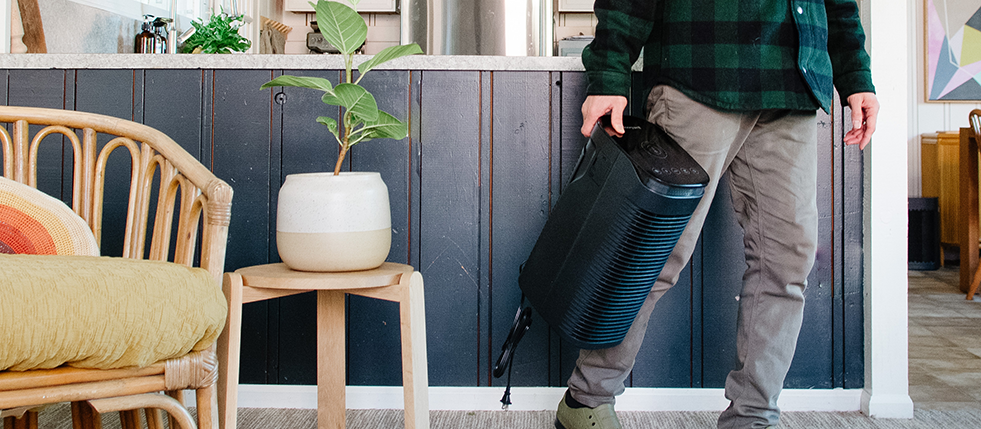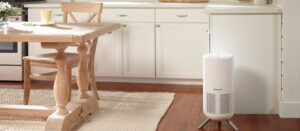Your houseplants. Even with all the love in the world, sometimes they just won’t flourish. But don’t start feeling bad about your green thumb. Simply getting the right humidity level in your home can help your plants thrive – and with significant benefits for you, too.
What is humidity?
Relative humidity (RH) is the kind of humidity talked about most often. RH is the amount of water vapor in the air, compared to how much water vapor the air could hold at its current temperature and pressure. Note that cold air cannot hold as much moisture as warm air. That’s why dry air is typically colder, and moist, humid air is typically warmer.
How does relative humidity affect houseplants?
Low relative humidity, not high, is often the culprit when it comes to humidity-perpetrated houseplant harm. This is because most plants don’t like dry environments, i.e., environments with a low relative humidity.
When RH is low (say, on a cold day), the air is dry and lacks moisture. As a result, the air will start drawing moisture out of stuff – like your houseplants.
Now technically, the “drawing-out of moisture” is good for plants. When plants transpire, they release moisture at their leaves, in the form of evaporation. Transpiring is what allows the plant to use the food and water you’ve dutifully provided for them, good plant-parent that you are.
The problem is, RH that is low will make your plants dry out – they’ll release moisture faster than you can replenish it. Even if you water your houseplants more frequently on cold, dry days, the leaves on a humidity-sensitive plant can start to turn brown and crisp. Enough water just can’t reach the leaves to counteract the rate of moisture loss.
Proper humidity, happy plants
With the right humidity level, your plants can transpire normally, i.e., not lose too much moisture. They will start to thrive!
There are several ways to help give your plants the humidity they need.
- Regularly mist your plants. You’ll need to do this several times a day in order to make a difference, but regularly misting your plants with warm water can help give them a more humid climate. In a very dry home (think wintertime with central heating), misting will be less effective.
- Group plants together. Combined with frequent misting, you can help your plants trap and take advantage of the moisture that they’re all giving off by grouping them together in one place, forming a little, humidity-conserving plant community.
- Create a terrarium. Some plants, like tropical plants and ferns, need very high humidity. You can buy a terrarium or create a glass enclosure (looking at you, old aquarium) in order to create a microclimate where moisture is trapped, and the plants can thrive.
- Use a humidifier. The easiest way to regulate the humidity in your home is with a humidifier – this way, you can take advantage of more humidity, too. Because it’s not just your plants that get dried out during the winter!
Humidity helps you, too
Cold, dry air is the source of many winter woes, including dry skin and chapped lips, irritated sinuses and throats, and even gaps in hardwood flooring. Since you can’t live in a terrarium with your plants (that’d be awesome, though), give yourself some wintertime relief with a humidifier:
- Help temporarily relieve dry, itchy skin, eyes and lips
- Help temporarily relieve congestion from colds or allergies
- Soothe irritated sinuses and throat
- Help yourself breathe more easily at night, so you can sleep more comfortably
- Helps reduce the survival of flu viruses on surfaces and in the air*
- Help prevent hardwood floors, wooden furniture and musical instruments from warping and cracking
- Make a cold room feel warmer and more comfortable
- Reduce static electricity, helping protect your electronics
Now that you know how humidity can benefit your plants (and you), find out which humidifier is the right one for your needs!
* STUDIES HAVE SHOWN THAT KEEPING INDOOR AIR AT AN RH LEVEL OF 40-60% REDUCES THE SURVIVAL OF FLU VIRUSES ON SURFACES AND IN THE AIR, COMPARED TO LOWER RH LEVELS. SEE, FOR EXAMPLE:
- REIMAN JM, DAS B, SINDBERG GM, URBAN MD, HAMMERLUND MEM, LEE HB, ET AL. (2018) HUMIDITY AS A NON-PHARMACEUTICAL INTERVENTION FOR INFLUENZA A. PLOS ONE 13(9): E0204337. HTTPS://DOI.ORG/10.1371/JOURNAL.PONE.0204337
- MYATT TA, KAUFMAN MH, ALLEN JG, MACINTOSH DL, FABIAN MP, & MCDEVITT JJ. (2010) MODELING THE AIRBORNE SURVIVAL OF INFLUENZA VIRUS IN A RESIDENTIAL SETTING: THE IMPACTS OF HOME HUMIDIFICATION. ENVIRONMENTAL HEALTH 9(55). HTTPS://DOI.ORG/10.1186/1476-069X-9-55














